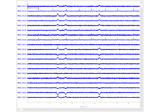mne.simulation.add_ecg#
- mne.simulation.add_ecg(raw, head_pos=None, interp='cos2', n_jobs=None, random_state=None, verbose=None)[source]#
Add ECG noise to raw data.
- Parameters
- rawinstance of
Raw The raw instance to modify.
- head_pos
None| path-like |dict|tuple|array Path to the position estimates file. Should be in the format of the files produced by MaxFilter. If dict, keys should be the time points and entries should be 4x4
dev_head_tmatrices. If None, the original head position (frominfo['dev_head_t']) will be used. If tuple, should have the same format as data returned byhead_pos_to_trans_rot_t. If array, should be of the form returned bymne.chpi.read_head_pos().- interp
str Either ‘hann’, ‘cos2’ (default), ‘linear’, or ‘zero’, the type of forward-solution interpolation to use between forward solutions at different head positions.
- n_jobs
int|None The number of jobs to run in parallel. If
-1, it is set to the number of CPU cores. Requires thejoblibpackage.None(default) is a marker for ‘unset’ that will be interpreted asn_jobs=1(sequential execution) unless the call is performed under ajoblib.parallel_configcontext manager that sets another value forn_jobs.- random_state
None|int| instance ofRandomState A seed for the NumPy random number generator (RNG). If
None(default), the seed will be obtained from the operating system (seeRandomStatefor details), meaning it will most likely produce different output every time this function or method is run. To achieve reproducible results, pass a value here to explicitly initialize the RNG with a defined state. The random generator state used for blink, ECG, and sensor noise randomization.- verbose
bool|str|int|None Control verbosity of the logging output. If
None, use the default verbosity level. See the logging documentation andmne.verbose()for details. Should only be passed as a keyword argument.
- rawinstance of
- Returns
- rawinstance of
Raw The instance, modified in place.
- rawinstance of
See also
Notes
The ECG artifacts are generated by:
Random inter-beat intervals are drawn from a uniform distribution of times corresponding to 40 and 80 beats per minute.
The activation function is the sum of three Hanning windows with varying durations and scales to make a more complex waveform.
The activated dipole is located one (estimated) head radius to the left (-x) of head center and three head radii below (+z) head center; this dipole is oriented in the +x direction.
Activations only affect MEG channels.
The scale-factor of the activation function was chosen based on visual inspection to yield amplitudes generally consistent with those seen in experimental data. Noisy versions of the activation will be stored in the first EOG channel in the raw instance, if it exists.
New in v0.18.

